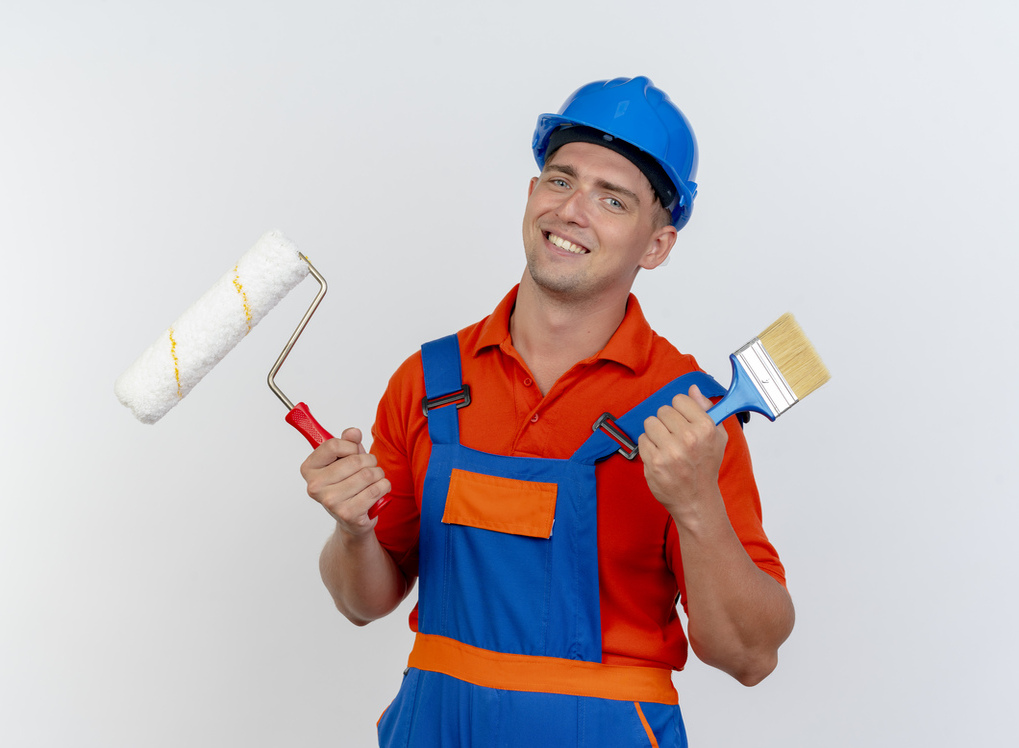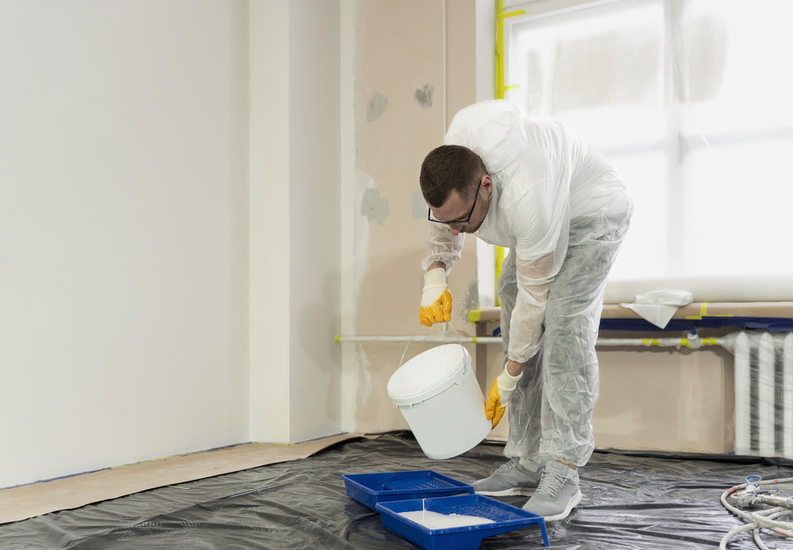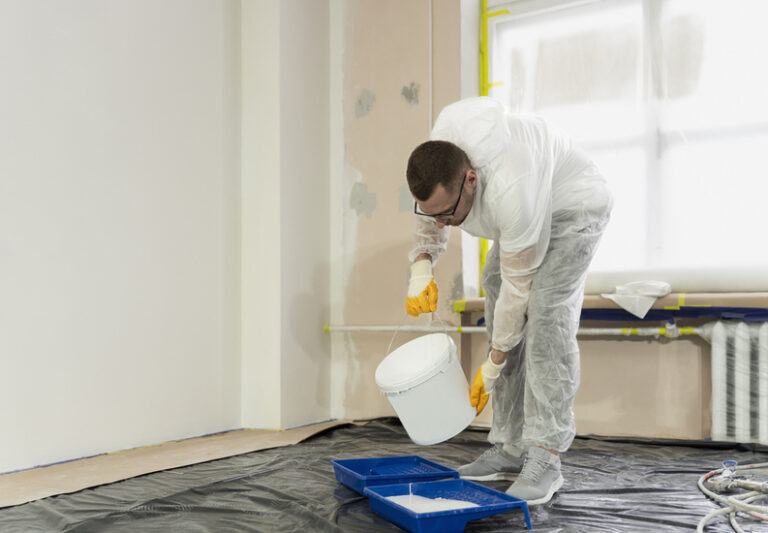This guide goes through the must-have gear every painter should consider, from basic brushes to advanced accessories. Whether you’re a seasoned pro or just starting, these tools will make your work cleaner, faster, and more fun.
Professional Painters: Must-Have Tools And Equipment
Pro painters need more than just paint and a brush. A good result depends on surface prep, quality tools, and workflow. Here are the must-have tools and equipment to get the job done.
Surface Preparation Tools
Before any paint touches the surface, preparation work needs to happen. Skipping this step can mean peeling, uneven texture, or poor adhesion.
- Scrapers And Putty Knives : Remove loose paint, wallpaper, and debris. Also good for applying fillers or smoothing over imperfections.
- Sanding Blocks And Electric Sanders : Smooth out rough spots and help new paint stick better. Sanding is critical on old walls or glossy finishes.
- Wall Filler or Spackling Compound : Fills small holes, cracks, or gouges. Once dry and sanded, it’s seamless.
- Painter’s Tape : Keeps lines crisp and prevents bleed-through. Good around trims, ceilings, and corners.
- Drop Cloths And Plastic Sheets : Protects flooring, furniture, and fixtures from spills and splatter.
Painting Tools
Once the surface is ready, you need tools that apply paint efficiently and with control. Each tool has a purpose and fits a particular type of surface or technique.
-
Paint Brushes
For cutting in, detailing, and getting into corners.
Types include:- Angled brushes for trim and edges
- Flat brushes for wide, straight lines
- Detail brushes for touch-ups and tight spots
-
Paint Rollers
For fast, even coverage on large flat areas like walls and ceilings.
Roller covers vary in:- Nap length: Short nap for smooth surfaces, longer nap for textured ones
- Material: Synthetic covers for latex paint, natural fiber for oil-based paint
-
Paint Sprayers
For large areas or hard-to-reach spots.- Airless sprayers cover fast with high-pressure
- HVLP sprayers offer more control with less overspray
Paint Containers And Accessories
Organizing and managing paint during the job will speed things up and reduce the mess.
- Paint Trays And Liners : For easy loading of rollers. Liners make cleanup quicker when switching colors.
- Buckets With Roller Grids : A better setup for bigger jobs. Grids remove excess paint without a tray.
- Pouring Spouts And Storage Lids:Prevent drips, spills, and wasted paint. Spouts improve pouring accuracy, lids keep paint fresh between sessions.
Ladders And Scaffolding
Safety and reach go hand in hand. Having the right equipment makes a difference when working above ground level.
- Step Ladders : Great for interior work or standard room heights.
- Extension Ladders : Reach higher walls, stairwells, or exteriors with adjustable length.
- Scaffolding Systems: Offer a wide, stable platform for ceilings or long stretches of wall.
Cleanup And Maintenance Supplies

Maintaining your tools extends their lifespan and keeps your work looking professional.
- Brush and Roller Cleaners : Designed to remove leftover paint and keep bristles or naps in good condition.
- Cloths, Sponges, and Wipes : Used for quick cleanups, edge corrections, or wiping down dust before painting.
- Solvents and Thinners : Necessary when using oil-based paints. These help with brush cleaning and surface prep.
- Protective Gear : Gloves protect your hands. Masks help you avoid fumes or dust. Goggles keep paint out of your eyes when spraying or scraping.
Finishing And Protection Materials
Finishing steps protect your work and enhance appearance.
- Varnishes : Shield the painting from dust and UV rays. Available in gloss, matte, or satin finishes.
- Fixatives : Prevent smudging in drawings or chalk-based artwork.
- Storage Containers : Keep unused paint sealed and brushes safe from damage.
Universal Painter’s Toolkit
Some items are useful for any kind of painter. Whether you’re working on drywall or detailing a canvas, these tools come in handy.
- Aprons Or Smocks : Keep clothes protected from drips and stains.
- Mixing Sticks : Stir paint evenly before use. Help maintain color consistency.
- Painter’s Tape : Used by artists for clean borders, straight lines, or blocking shapes.
- Toolboxes And Rolling Carts : Organize brushes, tools, and paints in one place.
- Sketchbooks Or Notepads : Plan compositions, test colors, or note ideas before starting.
Emerging Tools And Innovations
Painters today benefit from tools that didn’t exist a decade ago. These options add precision, efficiency, and sustainability to the process.
- Digital Color Matchers : Instantly scan a surface to find the closest matching paint shade.
- Eco-Friendly Paints and Brushes: Water-based, low-VOC formulas are better for indoor air and safer for the planet.
- Ergonomic Tools : Brushes with cushioned handles and angled grips reduce hand fatigue during long sessions.
- Mobile Lighting Systems : Portable, adjustable lights help artists work in varied environments.
Safety And Ergonomics For Painters
No matter the scale of the project, the painter’s safety matters. Taking small steps to protect yourself can prevent injury or health risks.
- Gloves And Masks : Keep skin safe from chemicals and prevent inhalation of fumes or dust.
- Ventilation Fans : Especially important in enclosed spaces where paint fumes can build up.
- Proper Posture And Breaks : Using adjustable easels or ladders helps reduce strain. Standing too long or hunching over can lead to long-term discomfort.
- Tool Maintenance : Sharp blades and clean brushes work better and require less force to use.
- Gloves And Masks : Keep skin safe from chemicals and prevent inhalation of fumes or dust.
Conclusion
Learning a skilled trade like painting is a difficult but worthwhile skill that requires attention and your interest. Every painter builds their toolkit over time. The right materials not only improve the result but also make the entire process more enjoyable and efficient. The tools listed here can help you do it better.
Investing in quality over quantity pays off in consistency, durability, and satisfaction. Painting isn’t just about what you create, it’s about how well you’re equipped to bring that vision to life.
Frequently Asked Questions
You’ll need scrapers, sanding blocks or electric sanders, wall filler, painter’s tape, and drop cloths for proper surface preparation.
Use brushes for detailed edges, rollers for large flat areas, and sprayers for fast, even coverage on big surfaces or hard-to-reach spots.
Use short nap covers for smooth surfaces like drywall and longer nap covers for textured surfaces like brick or stucco.
Clean brushes and rollers with water or solvent based on paint type, then store them dry. Use cleaners to extend tool life.
Painters should use gloves, masks, goggles, and sometimes knee pads or ventilation fans to protect against fumes, splashes, and strain.



